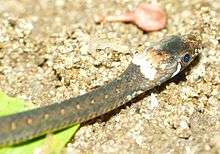Nilgiri keelback
| Nilgiri keelback | |
|---|---|
 | |
| Amphiesma beddomei | |
| Scientific classification | |
| Kingdom: | Animalia |
| Phylum: | Chordata |
| Subphylum: | Vertebrata |
| Class: | Reptilia |
| Order: | Squamata |
| Suborder: | Serpentes |
| Family: | Colubridae |
| Subfamily: | Natricinae |
| Genus: | Amphiesma |
| Species: | A. beddomei |
| Binomial name | |
| Amphiesma beddomei (Günther, 1864) | |
| Synonyms | |
| |
The Nilgiri keelback or Beddome's keelback (Amphiesma beddomei ) is a species of snake found in the Western Ghats in India.[1] The species is named after Richard Henry Beddome, 1830–1911, British army officer and botanist.[3] It was first discovered near the Nilgiris but is now known more widely from the Western Ghats. This snake is terrestrial and feeds on toads.
Description

- See snake scales for the terminology used
Eye moderate, its diameter in the adult equalling its distance from the nostril; rostral just visible from above; suture between the internasals as long as that between the prefrontals; frontal larger than its distance from the end of the snout, a little shorter than the parietals; loreal as long as deep or deeper than long; one preocular; three (rarely two) postoculars; temporals 1+1 or 1+2; upper labials 8 or 9, third, fourth and fifth, or fourth, fifth, and sixth entering the eye; 5 lower labials in contact with the anterior chin shields, which are shorter than the posterior.
Scales in 19 rows, rather strongly keeled, the outer however, perfectly smooth. Ventrals 131-150; anal divided; subcaudals 65-75.
Brown above; a series of yellow spots, each between two black spots or short transverse bands, along each side of the back; upper labials yellowish with black sutures; a yellow, black-edged, oblique streak from the eye to the gape; a yellow band across the nape, behind the parietals, becoming indistinct with age; belly white, closely dotted with brown on the sides.
Total length 51–66 cm (20–26 in), tail 13–19 cm (5–7 1⁄2 in).[4]

Habitat
Amphiesma beddomei prefers moist deciduous forests and evergreen forests.[5]
Behavior
Although not aquatic, it can be found actively hunting from dawn to dusk on stream banks or close to other bodies of water.[5]
Diet
References
- 1 2 Srinivasulu, C.; Srinivasulu, B.; Vijayakumar, S.P.; Jose, J. & Kulkarni, N.U. (2013). "Amphiesma beddomei". IUCN Red List of Threatened Species. Version 2014.2. International Union for Conservation of Nature. Retrieved 7 September 2014.
- ↑ Amphiesma beddomei at the Reptarium.cz Reptile Database. Accessed 7 September 2014.
- ↑ Beolens B, Watkins M, Grayson M. 2011. The Eponym Dictionary of Reptiles. Baltimore: Johns Hopkins University Press. xiii + 296 pp. ISBN 978-1-4214-0135-5. ( (Amphiesma beddomei) p. 21).
- ↑ Boulenger GA. 1893. Catalogue of the Snakes in the British Museum (Natural History). Volume I., Containing the Families ... Colubridæ Aglyphæ, Part.. London: Trustees of the British Museum (Natural History). xiii + 448 pp. + Plates I -XXVIII. (Tropidonotus beddomii, pp. 252-253).
- 1 2 3 Das I. 2002. A Photographic Guide to Snakes and Other Reptiles of India. Sanibel Island, Florida: Ralph Curtis Books. 144 pp. ISBN 0-88359-056-5. (Amphiesma beddomei, p. 17).
Further reading
- Günther A. 1864. The Reptiles of British India. London: The Ray Society. (Taylor and Francis, printers). xxvii + 452 pp. + Plates I- XXVI. (Tropidonotus beddomii [sic], p. 269 + Plate XXII, fig. E). PDF
- Smith MA. 1943. The Fauna of British India, Ceylon and Burma, including the Whole of the Indo-Chinese Sub-region. Reptilia and Amphibia, Vol. III.—Serpentes. London: The Secretary of State for India. (Taylor and Francis, Printers). London. xii + 583 pp. (Natrix beddomei, p. 306).
External links
| Wikimedia Commons has media related to Amphiesma beddomei. |
